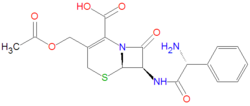Cefaloglycin: Difference between revisions
Jump to navigation
Jump to search

imported>David E. Volk No edit summary |
mNo edit summary |
||
| Line 23: | Line 23: | ||
== References == | == References == | ||
<references/> | <references/> | ||
{{CZMed}} | {{CZMed}}[[Category:Suggestion Bot Tag]] | ||
Latest revision as of 16:01, 25 July 2024
|
| |||||||
| cefaloglycin | |||||||
| |||||||
| Uses: | antibiotic drug | ||||||
| Properties: | beta-lactam | ||||||
| Hazards: | see drug interactions | ||||||
| |||||||
Cefaloglycin, also called cephaloglycin, is a first-generation cephalosporin type of antibiotic medication that is no longer commonly used. It antibacterial activity is due the core beta-lactam structure that is common among all cephalosporins.
Chemistry
The IUPAC name of cefaloglycin is (6R,7R)-3-(acetyloxymethyl)-7-[[(2R)-2-amino-2-phenylacetyl]amino]-8-oxo-5-thia-1-azabicyclo[4.2.0]oct-2-ene-2-carboxylic acid, and its molecule formula, C18H19N3O6S, indicates an average molecule mass of 405.4250 gram/mole.
References
The most up-to-date information about Cefaloglycin and other drugs can be found at the following sites.
- Cefaloglycin - FDA approved drug information (drug label) from DailyMed (U.S. National Library of Medicine).
- Cefaloglycin - Drug information for consumers from MedlinePlus (U.S. National Library of Medicine).
- Cefaloglycin - Detailed information from DrugBank.
